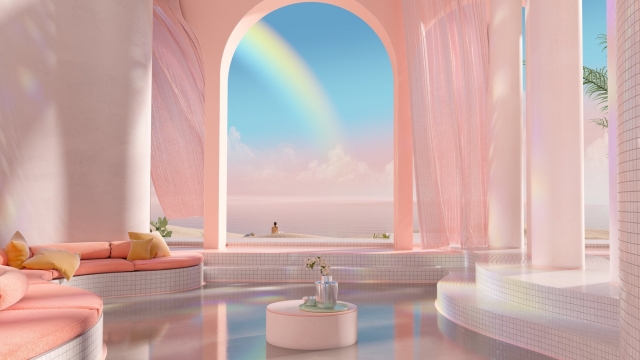From the towering structures that shape our city skylines to the intimate spaces that inspire a sense of belonging, architecture and interior design intertwine to forge an extraordinary symphony of spaces. Each element, meticulously crafted, harmonizes to create a unique experience that transcends mere physical functionality. Together, they shape our surroundings, reflect our culture, and influence the way we live and interact with our environment. The intersection of architecture and interior design presents a captivating realm where the boundaries blur, allowing for endless possibilities of creativity and innovation.
Architecture, the art and science of designing and constructing structures, sets the stage for the stories of our built environment. It encompasses grand buildings that become landmarks, bridges that connect communities, and homes that cocoon our lives. Its impact stretches far beyond aesthetics, influencing the functionality, durability, and sustainability of our surroundings. With its crucial role in shaping the world we inhabit, architecture becomes the backbone upon which interior design narratives unfold.
Interior design, on the other hand, delves into the intricacies and nuances of creating captivating and functional spaces within architectural frameworks. It sculpts an atmosphere that resonates with the needs, aspirations, and personalities of its users. Through the selection of materials, colors, textures, and furniture arrangements, interior design transforms empty shells into personalized sanctuaries and awe-inspiring public spaces. It is the art of curating experiences, crafting narratives, and evoking emotions within the enclosed boundaries of architecture.
In this article, we will explore the captivating world where architecture and interior design converge. We will delve into the symbiotic relationship they share, unravel the processes that intertwine their domains, and unravel the enchanting stories behind their collaborative efforts. Join us on this journey as we unravel the layers of this symphony of spaces and discover the magic that emerges when architecture and interior design intertwine in perfect harmony.
1. The Evolution of Architecture and Interior Design
Architecture and interior design have undergone a remarkable evolution throughout history. From ancient civilizations to the modern world, these disciplines have constantly adapted and transformed, shaping the way we perceive and interact with spaces.
Initially, architecture focused primarily on the construction of functional and aesthetically pleasing structures. Whether in the form of ancient temples or towering cathedrals, architects aimed to create harmonious spaces that reflected the values and beliefs of their time.
Interior design, on the other hand, evolved as a means to enhance these architectural spaces. In early civilizations, interior design was closely connected to societal status and symbolism. Elaborate furnishings, decorative artworks, and intricate detailing were used to create luxurious environments that reflected the wealth and power of their inhabitants.
As time progressed, architecture and interior design began to intertwine more closely. Architects started considering how interior spaces could affect the overall design of a building, leading to a greater emphasis on functionality and human experience. Interior designers, in turn, started collaborating with architects to ensure a unified vision that seamlessly integrated the exterior and interior elements of a space.
This symbiotic relationship between architecture and interior design continues to evolve today. Contemporary designers are not only focused on aesthetics and functionality but also on sustainability and environmental impact. The use of innovative materials and technologies has allowed for the creation of spaces that are not only visually stunning but also energy-efficient and eco-friendly.
In conclusion, the evolution of architecture and interior design has been a dynamic and transformative journey. From their origins as separate disciplines to their current collaboration and integration, these fields have shaped the way we live, work, and interact with our surroundings. Stay tuned for the next sections of this article as we explore further the fascinating world of architecture and interior design!

2. The Interplay of Form and Function
When it comes to the world of architecture and interior design, one cannot overlook the mesmerizing interplay of form and function. Both aspects are crucial in creating spaces that are not only visually stunning but also practical and efficient.
Form, in the context of architecture and interior design, refers to the aesthetic elements and visual appeal of a structure or space. It encompasses factors such as shape, color, texture, and proportion. Architects and designers carefully consider these elements to create spaces that evoke certain emotions or convey specific messages. From sleek and modern designs to ornate and traditional styles, the form of a building or interior can greatly influence the overall experience of the space.
On the other hand, function relates to the purpose and practicality of a structure or space. It involves understanding how people will interact with the environment and ensuring that it meets their needs. Functionality is achieved through thoughtful planning and consideration of factors such as space utilization, circulation, and accessibility. An architect or designer must strike a balance between creating a visually appealing space and ensuring that it serves its intended purpose effectively.
The interplay between form and function is a delicate dance, where the aesthetic vision must be harmoniously integrated with practical considerations. It is not enough for a structure or space to look striking; it must also be functional in its layout and utilize the available space efficiently. Successful architects and interior designers understand that the two aspects are intrinsically linked and should work in tandem to create spaces that are both visually captivating and purposeful.
Ultimately, the symphony of spaces created by the interplay of form and function in architecture and interior design has the power to inspire, uplift, and transform our daily lives. From grand public buildings to humble residential spaces, the careful balance between these two elements is what breathes life into our built environment, making it not just aesthetically pleasing, but also a joy to inhabit.
3. Creating Harmonious Living Spaces
Creating harmonious living spaces is the ultimate goal of the seamless integration between architecture and interior design. It is a delicate dance that requires a deep understanding of the spatial dynamics and the needs of the inhabitants. The success lies in the ability to harmonize the physical aspects of the structure with the aesthetics and functionality of the interior.
Explore
Architecture plays a crucial role in setting the stage for the interior design. The design of the building itself sets the tone and establishes the framework within which the interior design can thrive. The architectural elements such as the layout, structure, and materials used form the backbone of the living space, providing a solid foundation on which interior design can build upon.
Interior design, on the other hand, brings life and personality to the architectural structure. It takes into account the human experience and tailors the space to the specific needs and desires of the occupants. Through the careful selection of furniture, colors, lighting, and textures, interior design adds depth, warmth, and character to the living spaces, transforming mere structures into inviting homes.
When architecture and interior design seamlessly merge, they create a symphony of spaces—a harmonious interplay between the built environment and the human experience. It is through this collaboration that the true potential of both disciplines can be realized, resulting in living spaces that not only look beautiful but also serve their purpose effectively and enhance the quality of life for those who inhabit them.
















